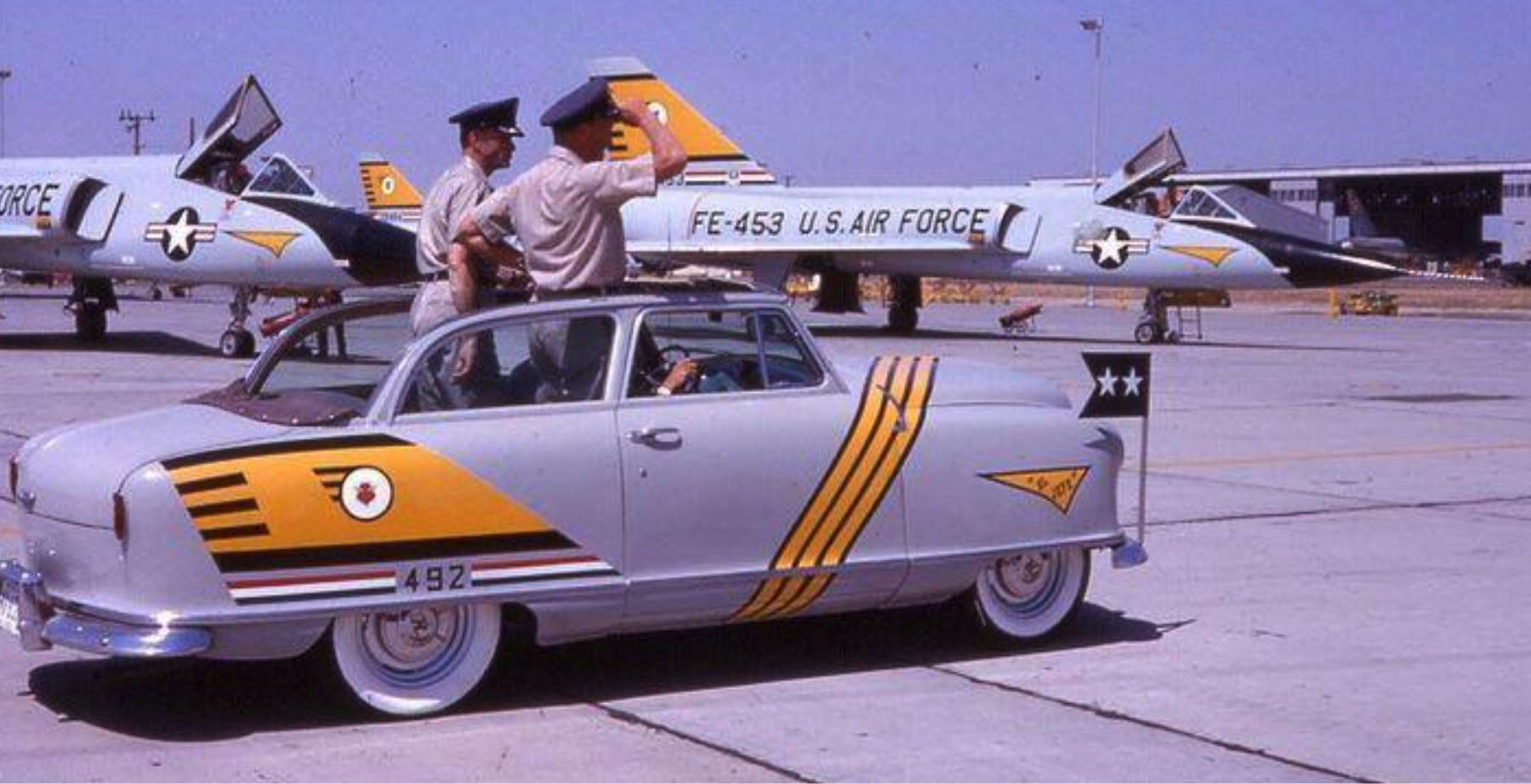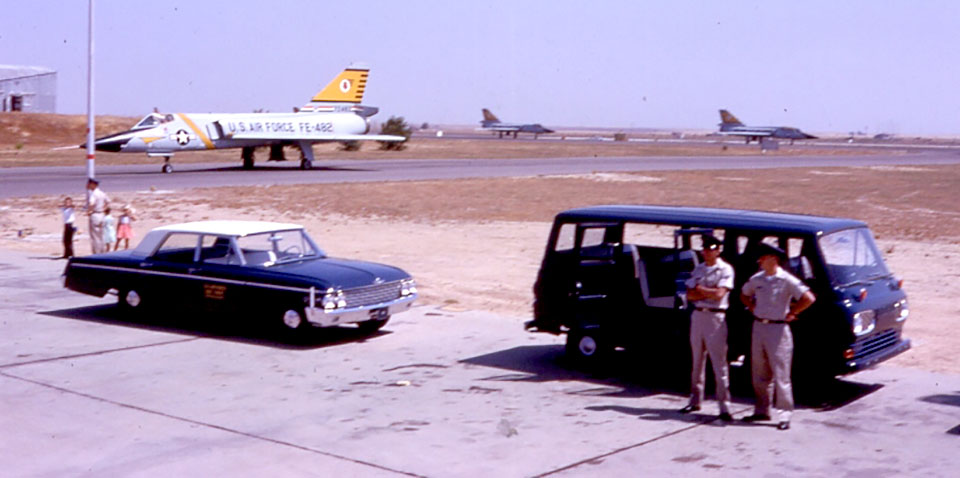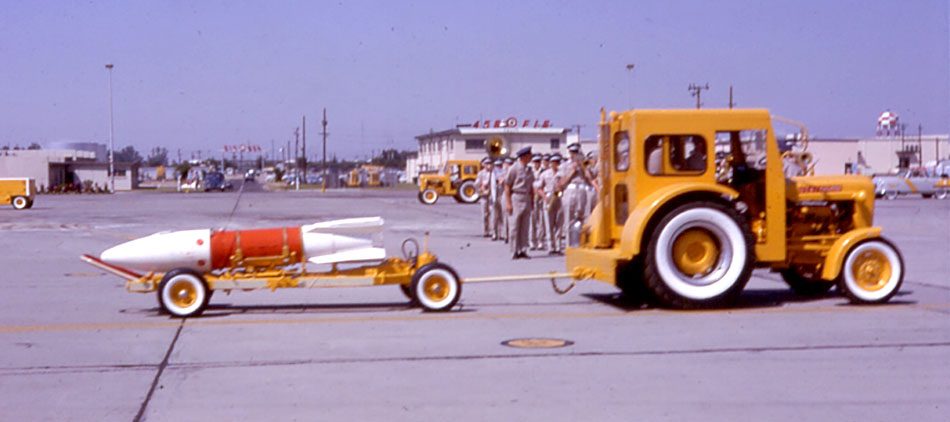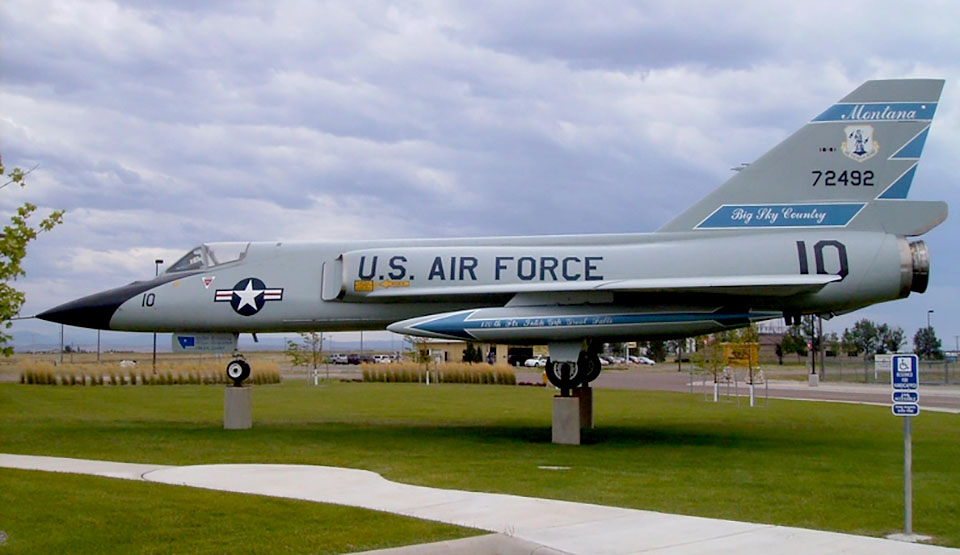Change of Command
How a Nash Rambler convertible was center stage in a traditional military ceremony.
Since ancient times, change of command ceremonies have marked the formal transfer of authority from one leader to another. In the military, time-honored symbolism is integral to the ceremonial aspects of a change of command, including an inspection and review of personnel, gun salutes, and accompaniment by a military band. A California-based U.S. Air Force unit, the 456th Fighter-Interceptor Squadron (FIS), added a special flourish to their ceremony in August 1963. As evidenced in the accompanying photographs, they displayed several vehicles marked in ways that indicate a special affinity for their leaders and an above average sense of pride in their unit.
At the time, the 456th FIS was based at Castle Air Force Base near Atwater, CA. It was one of over 30 U.S.-based Air Force fighter-interceptor units in the service’s Air Defense Command. They were all charged with defending the country from aerial attack during the period of the Cold War with the Soviet Union. The 456th’s area of responsibility was a large area of northern California and Nevada that included Castle Air Force Base (AFB) near Merced, CA. This facility was the 456th’s home where they were tenants on the installation that primarily housed B-52 bombers and KC-135 refueling aircraft of the 93rd Bombardment Wing (BW) in the Strategic Air Command (SAC). The 456th FIS’s mission aircraft was the Convair (now General Dynamics) F-106A Delta Dart, which entered service in 1959 and which the 456th received in that same year. The supersonic F-106, the last dedicated interceptor in the U.S. Air Force, carried an array of missiles to shoot down attacking bombers. Its sleek delta wing design resulted in one example setting a speed record in 1959 of 1,525.95 mph, or 2.39 Mach, which is still the fastest flight ever made by a single-engine jet.
The background regarding the 456th FIS’s change of command is that its then-current commander, Lieutenant Colonel (Lt. Col.) James L. Price, was moving on to a new assignment after leading the unit since July 1960. Under his command, in 1961 the 456th FIS had placed first in an annual and prestigious Air Force-wide rocketry competition among fighter-interceptor units called William Tell. As possible evidence of his esteem within the 456th FIS, Lt. Col. Price also had charge of the most prominent vehicle present on the day of the ceremony. The early 1950s Nash Rambler seen below was decorated by unit personnel in the color and markings copied from Lt. Col. Price’s assigned F-106 illustrated in the image underneath. The car’s pristine condition and immaculate finish are very apparent, with the whitewall tires adding a distinctly elegant touch to the car’s appearance.
-

Lt. Col. Price’s Nash Rambler convertible (top) carries the same markings as his F-106 aircraft (above). Per protocol, the flag on the front right bumper denotes that a 2-star general officer is aboard. At the time, Major General (MG) Conrad F. Necrason was commander of the 28th Air Division at Hamilton Air Force Base near San Francisco. The 456th FIS was a component unit of the 28th. It therefore seems likely that the flag is for MG Necrason, making the Nash an interesting platform from which to review the 456th’s personnel and facilities.
-

Another view of the Nash shows that its Landau top is rolled open with Lt. Col. Price (left) and MG Necrason (right) standing up in the back of the car. The duplicated markings of Lt. Col. Price’s F-106 are the same as the unit’s other F-106s with a few exceptions. The three stripes officially denote a squadron commander’s aircraft. The squadron’s emblem and markings on the rear fender include the last three digits of the serial number of Lt. Col. Price’s F-106. A placard on the right front fender bears the words “El Jefe”, Spanish for “chief” or “boss”.
The Nash Rambler was produced by the Nash division of the Nash-Kelvinator Company to be America’s first postwar compact car. It was developed in response to forecasts from economic experts who predicted that the postwar American economy would look much like it did prior to hostilities in that growth would be slow along with a tight job market. All of the automakers were designing small and low-priced vehicles in anticipation of this scenario. When sales figures soon revealed that big cars were what the public wanted, all of the companies except Nash dropped plans for smaller cars. However, Nash senior management, led by CEO George W. Mason, believed that smaller cars equipped with the standard features that American drivers wanted would be a desirable alternative to the flashy models produced by larger U.S. manufacturers. Upon its introduction to the public on April 10, 1950, the Rambler was offered as a European-style convertible whose lines were developed in part by Pininfarina, the famous Italian body designer. Its fixed door frames and roll-down fabric top that Nash called a Landau were inspired by the cars that servicemen returning from the war in Europe had seen and appreciated. The strategy included marketing the car as economical to operate but at a price that did not suggest low quality. The result was that the Rambler’s approximately $1800 price made it the lowest-priced convertible but not the lowest-priced car, since no-frills sedans from the Big Three were priced lower.
-

An example of Air Force fighter pilot’s interest in old cars is evidenced by wartime ace and test pilot Chuck Yeager at left. In 1952 he drove a Ford Model A while testing supersonic aircraft at Edwards AFB, CA. In the same year, a Ford Model A Tudor sedan in 75th FIS colors at Presque Isle AFB, ME has squadron commander stripes and whitewall tires just like the 456th FIS Rambler ten years later. At right, a 1950 Ford Custom sedan sports 37th FIS colors at Yuma AFB, AZ, where the unit was deployed from Ethan Allen AFB, VT in 1957. (Author)
At this point, readers may be puzzled by the choice of an older and fairly pedestrian car for use by personnel who may have been period examples of individuals with a “need for speed”. Intuitively, one might think that fighter pilots would opt for a more sporty-looking and high-performance machine. The aforementioned features were often exhibited in many unit members’ personal cars. However, the adoption of the Nash Rambler into the 456th FIS likely stems in part from a long-standing practice of older vehicles being acquired by individuals or groups of personnel within an air force unit and utilized for unofficial transportation needs. Much like the guidelines for hotrodders, older cars were sought that could be purchased cheaply, had plenty of sources for parts, and would be particularly distinctive after the application of unit colors and markings. For example, in 1952 renowned flying ace and test pilot Chuck Yeager owned a weathered, pale blue Model A Ford that he drove to work at the Air Force Flight Test Center at Edwards AFB, CA. Older vehicles were also kept for squadron member’s use on jaunts such as group excursions to favorite entertainment venues, particularly when units were deployed on temporary duty from their home base. The cars were often painted in squadron colors and markings and treated essentially as mascots of the owning unit. In many cases these vehicles were passed from one squadron member to another as personnel rotated in and out of a unit, and this scenario may have been the case with the Rambler. A close examination of the first image of the Rambler yields that it carries a Texas license plate in the center of the front bumper. It therefore may have originally belonged to a former squadron member who was a Texas resident before being passed on to other members over time.
-

Two official Air Force vehicles stood by during the ceremony. Resplendent in Air Force Blue with white top at left is a 1963 Ford Galaxie 500, possibly MG Necrason’s staff car, and a Ford E-100 Econoline van. In the background, F-106A serial number 57-2482 leads the other 456th FIS aircraft on their return after the ceremonial flyby. Its two stripes denote its assignment to the 456th FIS Director of Operations.
-

The ceremony even included the 456th FIS’s ground support equipment that were “dressed” for the occasion. Whitewall tires abound on a Ford 621 Tug towing an AIR-2A Genie nuclear air-to-air rocket on an MF-9 Transport Trailer. In the background at left is a TTU-228/E Hydraulic Test Stand that provides external hydraulic pressure for operating aircraft hydraulic systems while the engines are shut-down.
The 456th went a step further in the ceremony by also including usually unseen ground support vehicles on parade that were uncommonly well-trimmed for the event. The image above depicts a whitewall-equipped Ford 621 Tug towing an MF-9 Transport Trailer, also sporting whitewall tires, upon which an AIR-2A “Genie” air-to-air rocket is resting. The Genie was built by Douglas Aircraft (later merged with McDonnell Douglas and now absorbed into Boeing), became operational in late 1957, and after production ended in 1962 it remained in service until 1985. The Genie was unique in that it was the first nuclear-tipped missile in the world that was designed for use against aircraft. It was developed as a last-ditch weapon in the event that defending interceptor aircraft were vastly outnumbered by an attacking force. After expending conventional Hughes AIM-4F Falcon and AIM-4G Super Falcon missiles against individual aircraft, firing the Genie into an enemy formation and detonation of its 1-kiloton warhead (equivalent to 1,000 tons of TNT, enough to obliterate a city block) could destroy several aircraft at once. The thought was that since the attackers would be carrying atomic weapons, any fallout from a Genie nuclear burst would be preferable to having even one enemy bomber unleash its far more destructive payload.
At the conclusion of the ceremony Lt. Col. John H. (Buck) Rodgers assumed command of the 456th FIS. The 456th FIS continued to carry out its mission at Castle AFB under a succession of commanders until July 18, 1968. On this date, the 456th completed a relocation to Oxnard AFB, CA, as a result of a reorganization in what had become Aerospace Defense Command in January 1968. The 456th FIS was then inactivated on that same day. Its mission, personnel, and equipment were transferred to the 437th FIS, which had been based at Oxnard since 1955. Soon, in another reorganization the 437th FIS was inactivated in September 1968 and redesignated 460th FIS until Oxnard AFB was closed in late 1969. The 460th FIS relocated to Kingsley Field, OR, then after a year there moved to Grand Forks AFB, ND, where it was shut down in 1974 as a casualty of the post-Vietnam reduction of U.S. military forces.
Regarding the principal personnel involved in the 1963 change of command, Lt. Col. Price went from the 456th to other assignments, including a combat tour in Vietnam, and rose in rank to Major General. He was killed in the crash of F-106A serial number 59-0021 when it was hit by lightning during takeoff at Griffiss AFB, NY on May 15, 1973. Lt. Col. Rogers’ future assignments are unknown. He left the unit in August 1964, retired at some point as a full Colonel, and appears to have passed away in retirement on October 15, 2008. MG Necrason retired at this rank at some point, then served 12 years as adjutant general of military affairs for the state of Alaska. He received the Legion of Merit, the state’s highest military award, in 1995 and passed away on January 15, 1997 at the age of 85.
-

F-106A serial number 59-0069 is preserved at Great Falls International Airport, MT. It is displayed with serial number 57-2492, the same number as Lt. Col. Price’s F-106A, which last served with the 187th Fighter Squadron of the Montana Air National Guard at Great Falls.
Lt. Col. Price’s F-106A 57-2492 moved with the 456th to Oxnard AFB before being reassigned to other Air Force units until 1987, when it was withdrawn from active service as all F-106s were being retired. It was then converted into a drone aircraft and used as a high-speed expendable target for live missiles fired by F-15 and F-16 pilots. Serial number 57-2492 was shot down by a Raytheon AIM-120 missile on August 20, 1997. However, the aircraft lives on in a sense as its serial number is carried on F-106A 59-0069 which is displayed at Great Falls International Airport, MT. The original 57-2492 was last based with the 187th FIS which was an Air National Guard (ANG) unit at Great Falls that flew the F-106 from 1972-1987. It is displayed as a monument to the citizen/soldiers of the Montana ANG as well as to memorialize all of the personnel who have served in the air defense of our nation.
Finally, with respect to the 456th FIS’s Nash Rambler, no information has been found concerning its history after the departure of Lt. Col. Price. What is clear is that the evolution of the Nash Rambler design into a line of small economy cars was a cornerstone of the business strategy of American Motors; this was the company created from the merger in 1954 of Nash and the Hudson Motor Car Company. Nash Ramblers epitomize their builder’s place in automotive history as a producer of solidly reliable and economical vehicles whose distinctive lines continue to attract viewers at car shows. ![]()

